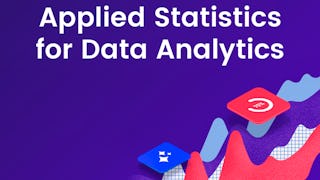This course aims to help you to draw better statistical inferences from empirical research. First, we will discuss how to correctly interpret p-values, effect sizes, confidence intervals, Bayes Factors, and likelihood ratios, and how these statistics answer different questions you might be interested in. Then, you will learn how to design experiments where the false positive rate is controlled, and how to decide upon the sample size for your study, for example in order to achieve high statistical power. Subsequently, you will learn how to interpret evidence in the scientific literature given widespread publication bias, for example by learning about p-curve analysis. Finally, we will talk about how to do philosophy of science, theory construction, and cumulative science, including how to perform replication studies, why and how to pre-register your experiment, and how to share your results following Open Science principles.

Cultivate your career with expert-led programs, job-ready certificates, and 10,000 ways to grow. All for $25/month, billed annually. Save now


Improving your statistical inferences

Instructor: Daniel Lakens
Top Instructor
76,621 already enrolled
Included with 
(792 reviews)
Skills you'll gain
Details to know

Add to your LinkedIn profile
24 assignments
See how employees at top companies are mastering in-demand skills


Earn a career certificate
Add this credential to your LinkedIn profile, resume, or CV
Share it on social media and in your performance review

There are 8 modules in this course
What's included
4 videos5 readings5 assignments
What's included
4 videos4 readings4 assignments
What's included
4 videos4 readings3 assignments
What's included
3 videos2 readings3 assignments
What's included
3 videos3 readings4 assignments
What's included
3 videos2 readings2 assignments
What's included
3 videos1 reading1 peer review
This module contains a practice exam and a graded exam. Both quizzes cover content from the entire course. We recommend making these exams only after you went through all the other modules.
What's included
3 assignments
Instructor

Offered by
Recommended if you're interested in Probability and Statistics


Eindhoven University of Technology


Johns Hopkins University


DeepLearning.AI


University of Leeds
Why people choose Coursera for their career




Learner reviews
792 reviews
- 5 stars
88.51%
- 4 stars
9.84%
- 3 stars
1.13%
- 2 stars
0.25%
- 1 star
0.25%
Showing 3 of 792
Reviewed on Jul 10, 2021
Solid course which taught me how to interpret p-values in a variety of contexts and taught me to not just to consider but (systematic and practical) ways of how to correct for publication bias.
Reviewed on Oct 5, 2017
This is a top-notch course. The ground (especially pitfalls) is very well covered, and useful free tools are engaged (R, G*Power, prof's own spreadsheets for calculating effect size).
Reviewed on Aug 5, 2020
Great course to dig a bit deeper into some very useful statistical concept. 4 starts as many of the contents are not "open" as the course preaches (see Microsoft Office documents or GPower).
New to Probability and Statistics? Start here.

Open new doors with Coursera Plus
Unlimited access to 10,000+ world-class courses, hands-on projects, and job-ready certificate programs - all included in your subscription
Advance your career with an online degree
Earn a degree from world-class universities - 100% online
Join over 3,400 global companies that choose Coursera for Business
Upskill your employees to excel in the digital economy
Frequently asked questions
All videos have English and Chinese subtitles. the assignments are only available in English.
Access to lectures and assignments depends on your type of enrollment. If you take a course in audit mode, you will be able to see most course materials for free. To access graded assignments and to earn a Certificate, you will need to purchase the Certificate experience, during or after your audit. If you don't see the audit option:
The course may not offer an audit option. You can try a Free Trial instead, or apply for Financial Aid.
The course may offer 'Full Course, No Certificate' instead. This option lets you see all course materials, submit required assessments, and get a final grade. This also means that you will not be able to purchase a Certificate experience.
When you purchase a Certificate you get access to all course materials, including graded assignments. Upon completing the course, your electronic Certificate will be added to your Accomplishments page - from there, you can print your Certificate or add it to your LinkedIn profile. If you only want to read and view the course content, you can audit the course for free.
More questions
Financial aid available,

